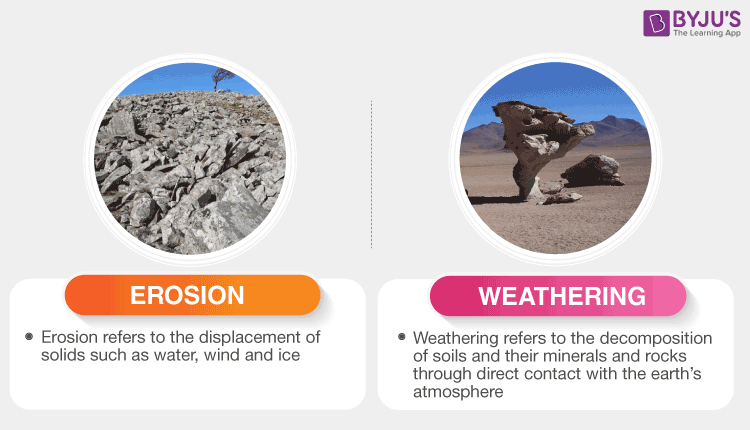What is Weathering?
The scenes of the world are continuously mutating. Sun, rain, frost, and wind are breaking down even the most solid of the rocks into smaller bits before they are taken away. This process is termed as weathering. The action of the elements of climate and weather, animals, and plants on the land surfaces to break them down biologically, chemically, and physically is called weathering. It is the breakdown and decay of rocks in situ. It can be a very elongated slow procedure, taking hundreds of years. However, weathering can also be rapid, such as the damage to pavements or roads after a cold, frosty winter.
Types of Weathering
Weathering is the initial step in soil creation. Weathering happens in four different manners: These include chemical weathering, physical weathering, biological weathering, and mechanical weathering. The three major ways weathering happens include chemical, physical, and mechanical weathering which are explained below.
How is Weathering different from Erosion?
Weathering has no moving agent of transport, whereas in Erosion the rock and upper layer soil particles are worn away and moved elsewhere by water, wind, etc.
How is Weathering different from Erosion?

Physical weathering happens when rocks are fragmented into minor fragments while ensuring no alterations in their chemical makeup. The main causes behind physical weathering include spontaneous fluctuations in temperature like too high or too low heat or cold. Variations in would be the causal element of freeze-thaw action and this occurs when water gets collected in the fissures in rocks all through the day and during the temperature drops at night that would be sufficient to freeze water into ice. It is a known fact that almost every substance grows in size when heated and contracts when exposed to low-temperature situations. Unlike these cases, water converts to ices when the temperature goes below zero and actually expands. The resultant action would result in the expansion of the fissure and thereby the structure of it weathers.
Chemical Weathering
Chemical weathering happens when the chemicals get diluted and dissolved in water and seep and percolate down the rock surfaces. Chemical weathering happens in areas having high temperatures and enough supply of water alike tropical environments that are humid. While the chemical weathering happens, the composition of minerals alters due to the reaction of chemicals in water or air. This also results in the rock decomposition. Some parts of the rock decomposition are carried away ping through rocks and soil, a procedure called leaching. The water ultimately may carry these materials to rivers and then to the sea. This is the source of the salinity of the oceans. The instances of chemical weathering are oxidation, the decay of calcium carbonate, etc.
Mechanical Weathering
Rocks are also fragmented by mechanical force. This procedure is called mechanical weathering. Because of the frequent variations in temperature, rocks begin to contract and expand. This action results in the breakdown of rocks. It is also caused by the roots of plants. They are growing through the cracks in the rocks and cracks the rocks apart. Chemical and mechanical weathering work together to break down rocks. Often, mechanical cracks and water seep into the rock and weather it chemically.

An excellent app which I need.